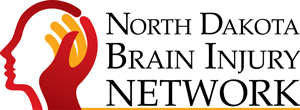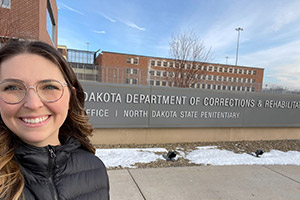Paving a Path to Resilience
By Jessica Rosencrans on
Brain injuries can happen suddenly, when you least expect it. Stroke, overdose, falling on ice, or playing contact sports are all ways that someone can experience a brain injury, which can lead to life-changing effects. Although they often pose a challenge to survivors, with the right resources and support systems, brain injury and its symptoms can be managed. But one population is often overlooked when it comes to brain injury: inmates.
 The North Dakota Brain Injury
Network (NDBIN), housed at the Center for Rural
Health within the University of North Dakota School of
Medicine & Health Sciences, was awarded a Justice and
Mental Health Collaboration Program grant in October
2024. The $550,000, three-year grant from the U.S. Department of Justice
will work to reduce recidivism among brain injury
survivors by providing resources, education, and support
to these populations while they are part of the justice
system.
The North Dakota Brain Injury
Network (NDBIN), housed at the Center for Rural
Health within the University of North Dakota School of
Medicine & Health Sciences, was awarded a Justice and
Mental Health Collaboration Program grant in October
2024. The $550,000, three-year grant from the U.S. Department of Justice
will work to reduce recidivism among brain injury
survivors by providing resources, education, and support
to these populations while they are part of the justice
system.
NDBIN has worked with individuals with brain injury and their families since 2010, providing education, peer support, and resources to connect brain injury survivors and increase public awareness of brain injury. However, the Justice and Mental Health Collaboration Program marks new ground for NDBIN, having focused their efforts primarily on the general population until now.
Within this grant, NDBIN is also collaborating with the North Dakota Department of Corrections and Rehabilitation (DOCR), the National Association of State Head Injury Administrators (NASHIA), and North Dakota Health and Human Services Behavioral Health Division.
Planning the route
The grant has five phases – planning, developing and implementing a training curriculum for correctional facility staff, facilitating a psychoeducation class in the North Dakota State Penitentiary, developing and implementing resource referral protocol, and increasing peer support systems for incarcerated individuals.

Currently, the collection of organizations is in the planning stage, where Carly Endres, senior project coordinator with NDBIN, said they are making good progress.
"We recently received approval from North Dakota DOCR to have someone who is incarcerated participate and sit in on the committee," Endres said. "One of our goals is to increase peer support, so it's critical to have people involved from every facet of the rehabilitation process."
The prevalence rate of brain injury across the criminal legal system is extremely high, ranging from approximately 50% to as high as 97% in female offenders.
NASHIA will utilize their expertise by aiding in the development of training for justice system staff, while the North Dakota DOCR is helping NDBIN to navigate the correctional facilities and the various rules and regulations that come hand-in-hand with working alongside incarcerated populations.
"The prevalence rate of brain injury across the criminal legal system is extremely high, ranging from approximately 50% to as high as 97% in female offenders," said Judy Dettmer, director of technical assistance and special projects at NASHIA.

"When the system does not recognize that the person has a brain injury and, therefore, does not provide adjustments and support, these individuals continue to fail in the system with the recidivism rates being almost double that of their peers without brain injury."
As Dettmer put it, those with brain injury "need the appropriate compensatory strategies, support, and referral to community supports to ensure they can stop the revolving door and stay out of the criminal legal system."
Learning from others
Collaboration is key to the success of this project. Stephanie Gravning, correctional health authority with the North Dakota DOCR, shared how the multitude of partnerships benefit the project.
"Not only does NDBIN have a curriculum, but they will also be working with us to do the programming themselves," Gravning explained. "This will strengthen access to care and other resources upon re-entry, which has been a major focus with incarcerated individuals returning to the community."
North Dakota isn't the only state to set out to increase resources for incarcerated brain injury survivors. Colorado has been working to implement brain injury screening and classes into the correctional facilities, and Utah received the same grant as NDBIN, just one year prior. Having other organizations to reach out to for support and advice has been invaluable.
"A big thing with brain injury that I've learned is that it's very collaborative," Endres commented. "Each state is very willing to share resources and ideas, pitfalls, and celebrations. It's a big part of the culture within brain injury support."
Education courses
Education goals for the grant are two-fold: training the correctional staff and informing brain injury survivors about their injury. The current goal is to have the staff training implemented by the end of the first year.
The North Dakota State Penitentiary (NDSP) was chosen as the best place to initiate this effort.
"We are primarily using NDSP because this is the intake facility for every male who is incarcerated in the state of North Dakota," said Gravning. "By focusing on identification at intake, we are able to find those who qualify for the programming offered through the grant and determine how best to connect that patient with those resources. We will plan to expand this to our female residents as well via their intake facility."
Given the novelty of this project, said Endres, the team was bound to encounter a few barriers during planning that required a workaround.
"With five of us at NDBIN, we realize that it's not going to be feasible for one of us to go in and host an in-person training session each time NDSP needs one," Endres said, "so ideally the training will be in an online format."

NDBIN, at NDSP.
Another barrier the group has encountered are the restrictions for materials brought into the State Penitentiary.
"You literally can't bring anything with you: no pens or pencils, no phone, so even accessing the materials for the training would be difficult to navigate if we held these training sessions in person. The online format will help remove some of those barriers," Endres said.
NDBIN currently offers a Living Life Fully After Brain Injury course to the general public, which would serve as a model for the psychoeducation course they plan to implement at the State Penitentiary. This is a seven-week course similar to one implemented in Colorado correctional facilities, which has resulted in a drop in recidivism rates among those who have taken the course.
"It's really cool when you teach this class and see how powerful it is," Endres said. "People have approached me and said that this class changed their life."
Providing the tools
"Ultimately, I hope that our efforts will lead to improved outcomes, including a reduction of recidivism, for individuals with brain injury," Dettmer commented. "North Dakota is a leader in the country with innovation as it relates to brain injury. This will further that recognition!"
Brain injury is an explanation, not an excuse. We aren't ever excusing criminal behavior, but we want to explain it.
Many factors result in an individual being incarcerated. Brain injuries happen and then they get forgotten about. People don't always know that they have a brain injury, or don't attribute symptoms to a brain injury correctly. Most traumatic brain injuries happen between the ages of 0-5, 15-19, and 65 or older. These injuries that happen early in life don't always show affects until the brain is fully developed – at around age 25.
"I do believe in second chances and rehabilitation," Endres chimed in. "Brain injury is an explanation, not an excuse. We aren't ever excusing criminal behavior, but we want to explain it. You don't get a free pass to commit crime if you have a brain injury, but you can explain why – because this population can lack certain tools. And we as NDBIN are here to provide those tools."


 is the communication specialist with the Center for Rural
Health at the University of North Dakota School of
Medicine & Health Sciences in Grand Forks.
is the communication specialist with the Center for Rural
Health at the University of North Dakota School of
Medicine & Health Sciences in Grand Forks.



